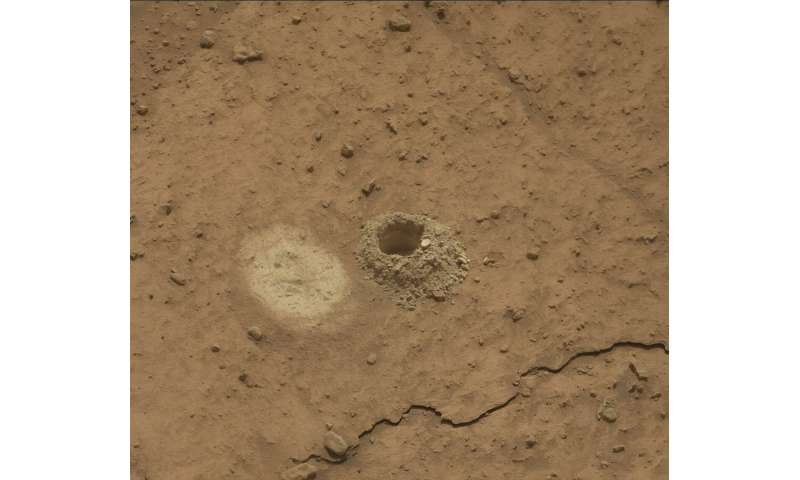Sols 4222–4224: A particularly prickly power puzzle

All our patient waiting has been rewarded, as we were greeted with the news that our drill attempt of Mammoth Lakes 2 was successful! You can see the drill hole in the image above, as well as the first place we attempted just to the left.
The actual drilling is only the beginning—we want to see what it is we've drilled. We're starting that process this weekend by using our laser spectrometer (LIBS) to check out the drill hole before delivering some of the drilled material to CheMin (the Chemistry & Mineralogy X-Ray Diffraction instrument) to do its own investigations.
The next step in a drill campaign is usually to continue the analysis with SAM (the Sample Analysis at Mars instrument suite), which tends to be quite power hungry. As a result, we want to make sure we're going into the next plan with enough power for that. That meant that even though we've got a lot of free time this weekend, with three sols and CheMin taking up only the first overnight, we needed to think carefully about how we used that free time.
Sometimes, when the science teams deliver our plans, we're overly optimistic. At times this optimism is rewarded, and we're allowed to keep the extra science in the plan. Today we needed to strategize a bit more, and the midday science operations working group meeting (or SOWG, as it's known) turned into a puzzle session, as we figured out what could move around and what we had to put aside for the time being.
An unusual feature of this weekend's plan was a series of short change-detection observations on Walker Lake and Finch Lake, targets we've looked at in past plans to see wind-driven movement of the Martian sand. These were peppered through the three sols of the plan, to see any changes during the course of a single sol.
While these are relatively short observations—only a few minutes—we do have to wake the rover to take them, which eats into our power. Luckily, the science team had considered this, and classified the observations as high, middle, or low priority. This made it easy to take out the ones that were less important, to save a bit of power.
Another power-saving strategy is considering carefully where observations go. A weekend plan almost always includes an AM ENV Science Block—dedicated time for morning observations of the environment and atmosphere.
Usually, this block goes on the final sol of the plan, but we already had to wake up the morning of the first sol for CheMin to finish up its analysis. This meant we could move the morning ENV block to the first sol, and Curiosity got a bit more time to sleep in, at the end of the plan.
Making changes like these meant not only that we were able to finish up the plan with enough power for Mondays activities, but we were still able to fit in plenty of remote science. This included a number of mosaics from both Mastcam and ChemCam on past targets such as Whitebark Pass and Quarry Peak.
We also had two new LIBS targets: Broken Finger Peak and Shout of Relief Pass. Aside from our morning block, ENV was able to sneak in a few more observations: a dust-devil movie, and a line-of-sight and tau to keep an eye on the changing dust levels in the atmosphere.
Provided by NASA